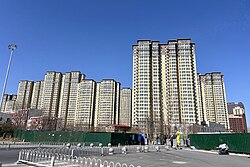Fatou Subdistrict (Chinese: 垡头街道; pinyin: Fátóu Jiēdào) is a subdistrict on the southern part of Chaoyang District, Beijing, China. It borders Wangsiying Township to the north, Dougezhuang Township to the east, Shibalidian Township to the south, and Nanmofang Township to the northwest. As of 2020, it has a total population of 78,952.[1]
Fatou Subdistrict
垡头街道 | |
|---|---|
 Yanbao Qidong Community built on the site of former Beijing Coking Chemical Factory within Fatou | |
| Coordinates: 39°51′59″N 116°30′14″E / 39.86639°N 116.50389°E | |
| Country | China |
| Municipality | Beijing |
| District | Chaoyang |
| Village-level Divisions | 16 communities |
| Area | |
• Total | 9.6 km2 (3.7 sq mi) |
| Population (2020) | |
• Total | 78,952 |
| • Density | 8,200/km2 (21,000/sq mi) |
| Time zone | UTC+8 (China Standard) |
| Postal code | 100023 |
| Area code | 010 |
The subdistrict was named after Fatou (Chinese: 垡头; lit. 'Plough Head') Village in the area, which in turn was named so its glutinous and heavy soil during planting season. Fatou Village first appeared on record in 1593.[2]
History
edit| Time | Status |
|---|---|
| 1960 | Created as Fatou Subdistrict |
| 1965 | Changed to People's Commune of Fatou |
| 1968 | Changed to Shuguangli Subdistrict |
| 1978 | Restored as Fatou Subdistrict |
Administrative Division
editIn 2021, there are a total of 16 communities under Fatou Subdistrict:[4]
| Administrative Division Code | Community Name in English | Community Name in Simplified Chinese |
|---|---|---|
| 110105019013 | Yiqu | 一区 |
| 110105019014 | Erqu | 二区 |
| 110105019015 | Sanqu | 三区 |
| 110105019016 | Dongli | 东里 |
| 110105019017 | Xili | 西里 |
| 110105019018 | Beili | 北里 |
| 110105019024 | Cuicheng Xinyuan | 翠城馨园 |
| 110105019025 | Cuicheng Yayuan | 翠城雅园 |
| 110105019026 | Cuicheng Quyuan | 翠城趣园 |
| 110105019027 | Cuicheng Shengyuan | 翠城盛园 |
| 110105019028 | Cuicheng Xiyuan | 翠城熙园 |
| 110105019029 | Shuanghe Jiayuan | 双合家园 |
| 110105019030 | Cuicheng Fuyuan | 翠城福园 |
| 110105019031 | Qidong Jiayuan | 祈东家园 |
| 110105019032 | Beijiao Jiayuan | 北焦家园 |
| 110105019033 | Shuangmei Jiayuan | 双美家园 |
References
edit- ^ 国家统计局, ed. (2020). 中国统计年鉴 [China statistical yearbook]. Vol. 39 (1st ed.). Beijing: 中国统计出版社. ISBN 978-7-5037-9225-0. OCLC 1262741013.
- ^ Hu,Liping; 户力平 (2020). Bei jing di tie zhan ming zhang gu = Allusions in the subway stations' name of Beijing (Di 1 ban ed.). Beijing: Dong fang chu ban she. ISBN 978-7-5207-1180-7. OCLC 1243234501.
- ^ 李立国; 李万钧; 吴世民, eds. (2013). 中华人民共和国政区大典, 北京市卷. Beijing: 中国社会出版社. ISBN 978-7-5087-4058-4. OCLC 910451741.
- ^ "2021年统计用区划代码和城乡划分代码". Retrieved 2022-09-22.

